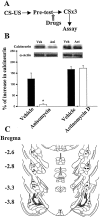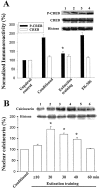The similarities and diversities of signal pathways leading to consolidation of conditioning and consolidation of extinction of fear memory
- PMID: 12967993
- PMCID: PMC6740702
- DOI: 10.1523/JNEUROSCI.23-23-08310.2003
The similarities and diversities of signal pathways leading to consolidation of conditioning and consolidation of extinction of fear memory
Abstract
It is generally believed that consolidation of long-term memory requires activation of protein kinases, transcription of genes, and new protein synthesis. However, little is known about the signal cascades involved in the extinction of memory, which occurs when the conditioned stimulus is no longer followed by the unconditioned stimulus. Here, we show for the first time that an intra-amygdala injection of transcription inhibitor actinomycin D at the dose that blocked acquisition failed to affect extinction of a learned response. Conversely, protein synthesis inhibitor anisomycin blocked both acquisition and extinction. Extinction training-induced expression of calcineurin was blocked by anisomycin but not by actinomycin D. NMDA receptor antagonist, phosphatidylinositol 3-kinase (PI-3 kinase), and MAP kinase inhibitors that blocked the acquisition also blocked the extinction of conditioned fear. Likewise, PI-3 kinase inhibitor blocked fear training-induced cAMP response element-binding protein (CREB) phosphorylation as well as extinction training-induced decrease in CREB phosphorylation, the latter of which was associated with calcineurin expression and could be reversed by a specific calcineurin inhibitor. Thus, molecular processes that underlie long-term behavioral changes after acquisition and extinction share some common mechanisms and also display different characteristics.
Figures






Similar articles
-
Identification of calcineurin as a key signal in the extinction of fear memory.J Neurosci. 2003 Mar 1;23(5):1574-9. doi: 10.1523/JNEUROSCI.23-05-01574.2003. J Neurosci. 2003. PMID: 12629159 Free PMC article.
-
Memory consolidation of auditory pavlovian fear conditioning requires protein synthesis and protein kinase A in the amygdala.J Neurosci. 2000 Sep 15;20(18):RC96. doi: 10.1523/JNEUROSCI.20-18-j0003.2000. J Neurosci. 2000. PMID: 10974093 Free PMC article.
-
Facilitation of conditioned fear extinction by systemic administration or intra-amygdala infusions of D-cycloserine as assessed with fear-potentiated startle in rats.J Neurosci. 2002 Mar 15;22(6):2343-51. doi: 10.1523/JNEUROSCI.22-06-02343.2002. J Neurosci. 2002. PMID: 11896173 Free PMC article.
-
Role of the amygdala in fear extinction measured with potentiated startle.Ann N Y Acad Sci. 2003 Apr;985:218-32. doi: 10.1111/j.1749-6632.2003.tb07084.x. Ann N Y Acad Sci. 2003. PMID: 12724161 Review.
-
Is an epigenetic switch the key to persistent extinction?Neurobiol Learn Mem. 2011 Jul;96(1):35-40. doi: 10.1016/j.nlm.2011.04.012. Epub 2011 Apr 23. Neurobiol Learn Mem. 2011. PMID: 21536141 Free PMC article. Review.
Cited by
-
Potentiation of GluN2C/D NMDA receptor subtypes in the amygdala facilitates the retention of fear and extinction learning in mice.Neuropsychopharmacology. 2014 Feb;39(3):625-37. doi: 10.1038/npp.2013.241. Epub 2013 Sep 6. Neuropsychopharmacology. 2014. PMID: 24008353 Free PMC article.
-
Anisomycin infused into the hippocampus fails to block "reconsolidation" but impairs extinction: the role of re-exposure duration.Learn Mem. 2006 Jan-Feb;13(1):27-34. doi: 10.1101/lm.91206. Learn Mem. 2006. PMID: 16452651 Free PMC article.
-
Evidence for recovery of fear following immediate extinction in rats and humans.Learn Mem. 2008 May 28;15(6):394-402. doi: 10.1101/lm.909208. Print 2008 Jun. Learn Mem. 2008. PMID: 18509113 Free PMC article.
-
Impaired fear extinction learning and cortico-amygdala circuit abnormalities in a common genetic mouse strain.J Neurosci. 2008 Aug 6;28(32):8074-85. doi: 10.1523/JNEUROSCI.4904-07.2008. J Neurosci. 2008. PMID: 18685032 Free PMC article.
-
Retrieval-Dependent Mechanisms Affecting Emotional Memory Persistence: Reconsolidation, Extinction, and the Space in Between.Front Behav Neurosci. 2020 Sep 29;14:574358. doi: 10.3389/fnbeh.2020.574358. eCollection 2020. Front Behav Neurosci. 2020. PMID: 33132861 Free PMC article. Review.
References
-
- Atkins CM, Selcher JC, Petraitis JJ, Trzaskos JM, Sweatt JD ( 1998) The MAPK cascade is required for mammalian associative learning. Nat Neurosci 7 : 602-609. - PubMed
-
- Bailey DJ, Kim JJ, Sun W, Thompson RF, Helmstetter FJ ( 1999) Acquisition of fear conditioning in rats requires the synthesis of mRNA in the amygdala. Behav Neurosci 113 : 276-282. - PubMed
-
- Barco A, Alarcon JM, Kandel ER ( 2002) Expression of constitutively active CREB protein facilitates the late phase of long-term potentiation by enhancing synaptic capture. Cell 108 : 689-703. - PubMed
-
- Baum M ( 1988) Spontaneous recovery from the effects of flooding (exposure) in animals. Behav Res Ther 26 : 185-186. - PubMed
Publication types
MeSH terms
Substances
LinkOut - more resources
Full Text Sources
Other Literature Sources
Medical
Research Materials
Miscellaneous
